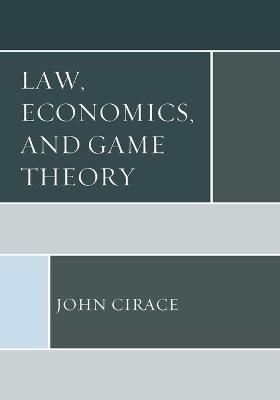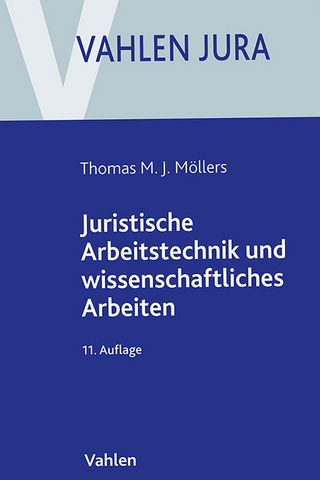
Law, Economics, and Game Theory
Lexington Books (Verlag)
978-1-4985-4910-3 (ISBN)
This book considers three relationships: law and economics; economics and game theory; and game theory and law. Economists teach lawyers that economic principles cut across and integrate seemingly different legal subjects such as contracts, torts, and property. Correspondingly, lawyers teach economists that legal rationality is a separate and distinct decision-making process that can be formalized by behavioral rules that are parallel to and comparable with the behavioral rules of economic rationality, that efficiency often must be constrained by legal goals such as equal protection of the laws, due process, and horizontal and distributional equity, and that the general case methodology of economics vs. the hard case methodology of law for determining the truth or falsity of economic theories and theorems sometimes conflict.
Economics and Game Theory: Law and economics books focus on economic analysis of judges’ decisions in common law cases and have been mostly limited to contracts, torts, property, criminal law, and suit and settlement. There is usually no discussion of the many areas of law that require cooperative action such as is needed to provide economic infrastructure, control public “bad” type externalities, and make legislation. Game theory provides the bridge between competitive markets and the missing discussion of cooperative action in law and economics. How? Competitive markets are examples (subset) of the Prisoners’ Dilemma, which explains the conflict between individual self-interested behavior and cooperation both in economic markets and in legislative bodies and demonstrates the need for social infrastructure and regulation of pollution and global warming.
Game Theory and Law: Lawsuits usually involve litigation between two parties, not the myriad participants in markets, so the assumption of self-interest constrained by markets does not carry over to legal disputes involving one-on-one bargaining in which the law gives one party superior bargaining power. Game theory models predict the effect of different legal institutions, rights, and rules on the outcome of such bargaining. Game theory also has a natural four-model framework which is used in this book to analyze the law and economics of civil obligation, which consists of torts (negligence), contracts, and unjust enrichment.
John Cirace is professor of economics and business law at Lehman College, CUNY, and adjunct professor of law at Brooklyn Law School.
Acknowledgments
Illustrations
IntroductionPart I: When are Thinking like an Economist and Thinking like a Lawyer Consistent?Chapter 1: Pareto Efficiency and Kaldor-Hicks Criterion Compared
Chapter 2: Rational Economic Behavior and Logic Defined
Chapter 3: Judicial Use of Economic Rationality (Efficiency)
Chapter 4: Equal Protection and Lexical Constraints on Efficiency
Chapter 5: Legal Rationality and Logic Defined
Chapter 6: When are Law and Economics Consistent (Isomorphic)?
Part II: Providing Infrastructure and Controlling Externalities Requires Resolving Conflicts between Individual Self-Interest and CooperationChapter 7: Prisoners’ Dilemma and Introduction to Game Theory
Chapter 8: Market and Government Failures as Prisoners’ Dilemmas
Chapter 9: Five Requirements for Competitive Markets
Chapter 10: In the Long Run We Are All Dead
Part III: General Case vs. Hard Case Methodologies: Rottenberg, Coase, Calabresi, and PosnerChapter 11: Rottenberg’s Theorem: Effect of a Change in Property Rights on Free Markets
Chapter 12: Coase’s Theorems: Effect of Property Rights and Liability Rules on Mutually Interfering Activities
Chapter 13: Calabresi’s Criteria for Allocating Accident Costs Common to Several Activities
Chapter 14: Posner’s Economic Analysis of the Common Law
Part IV: Risk, Insurance, and Incomplete Information Chapter 15: Risk, Insurance, Judge Hand Test, and Value of a Statistical Life
Chapter 16: Incomplete Information: Adverse Selection, Moral Hazard, and Principal-Agent Problem
Part V: Law and Economics of Civil Obligation
Chapter 17: Game Theoretic Framework for Law and Economics of Civil Obligation
Chapter 18: Torts: Negligence and Products Liability
Chapter 19: Strict Rules, Competitive Market Contract Model
Chapter 20: Discretionary Standards, Imperfect Competition Contract Model
Chapter 21: Decision Theory, Suit, and Settlement
Bibliography
About the Author
| Erscheinungsdatum | 10.05.2021 |
|---|---|
| Verlagsort | Lanham, MD |
| Sprache | englisch |
| Maße | 177 x 245 mm |
| Gewicht | 703 g |
| Themenwelt | Recht / Steuern ► Allgemeines / Lexika |
| Recht / Steuern ► EU / Internationales Recht | |
| Wirtschaft ► Volkswirtschaftslehre | |
| ISBN-10 | 1-4985-4910-1 / 1498549101 |
| ISBN-13 | 978-1-4985-4910-3 / 9781498549103 |
| Zustand | Neuware |
| Informationen gemäß Produktsicherheitsverordnung (GPSR) | |
| Haben Sie eine Frage zum Produkt? |
aus dem Bereich


